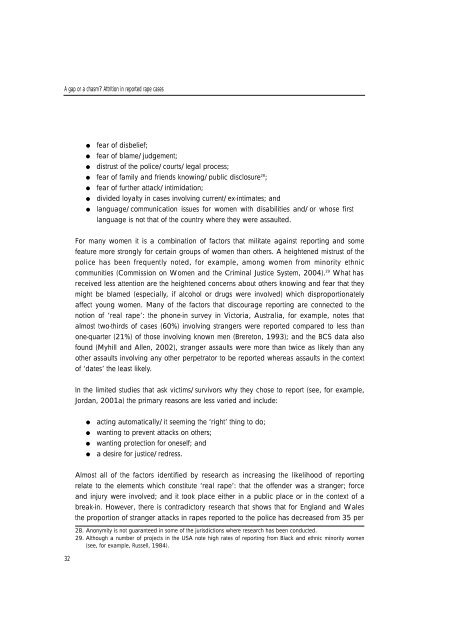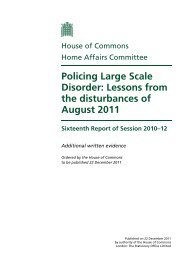A gap or a chasm? - National Police Library Online Catalogue
A gap or a chasm? - National Police Library Online Catalogue
A gap or a chasm? - National Police Library Online Catalogue
Create successful ePaper yourself
Turn your PDF publications into a flip-book with our unique Google optimized e-Paper software.
A <strong>gap</strong> <strong>or</strong> a <strong>chasm</strong>? Attrition in rep<strong>or</strong>ted rape cases<br />
32<br />
● fear of disbelief;<br />
● fear of blame/judgement;<br />
● distrust of the police/courts/legal process;<br />
● fear of family and friends knowing/public disclosure 28 ;<br />
● fear of further attack/intimidation;<br />
● divided loyalty in cases involving current/ex-intimates; and<br />
● language/communication issues f<strong>or</strong> women with disabilities and/<strong>or</strong> whose first<br />
language is not that of the country where they were assaulted.<br />
F<strong>or</strong> many women it is a combination of fact<strong>or</strong>s that militate against re p o rting and some<br />
feature m<strong>or</strong>e strongly f<strong>or</strong> certain groups of women than others. A heightened mistrust of the<br />
police has been frequently noted, f<strong>or</strong> example, among women from min<strong>or</strong>ity ethnic<br />
communities (Commission on Women and the Criminal Justice System, 2004). 29 What has<br />
received less attention are the heightened concerns about others knowing and fear that they<br />
might be blamed (especially, if alcohol <strong>or</strong> drugs were involved) which dispro p o rt i o n a t e l y<br />
affect young women. Many of the fact<strong>or</strong>s that discourage rep<strong>or</strong>ting are connected to the<br />
notion of ‘real rape’: the phone-in survey in Vict<strong>or</strong>ia, Australia, f<strong>or</strong> example, notes that<br />
almost two-thirds of cases (60%) involving strangers were rep<strong>or</strong>ted compared to less than<br />
one-quarter (21%) of those involving known men (Brereton, 1993); and the BCS data also<br />
found (Myhill and Allen, 2002), stranger assaults were m<strong>or</strong>e than twice as likely than any<br />
other assaults involving any other perpetrat<strong>or</strong> to be rep<strong>or</strong>ted whereas assaults in the context<br />
of ‘dates’ the least likely.<br />
In the limited studies that ask victims/surviv<strong>or</strong>s why they chose to rep<strong>or</strong>t (see, f<strong>or</strong> example,<br />
J<strong>or</strong>dan, 2001a) the primary reasons are less varied and include:<br />
● acting automatically/it seeming the ‘right’ thing to do;<br />
● wanting to prevent attacks on others;<br />
● wanting protection f<strong>or</strong> oneself; and<br />
● a desire f<strong>or</strong> justice/redress.<br />
Almost all of the fact<strong>or</strong>s identified by re s e a rch as increasing the likelihood of re p o rt i n g<br />
relate to the elements which constitute ‘real rape’: that the offender was a stranger; f<strong>or</strong>ce<br />
and injury were involved; and it took place either in a public place <strong>or</strong> in the context of a<br />
break-in. However, there is contradict<strong>or</strong>y research that shows that f<strong>or</strong> England and Wales<br />
the prop<strong>or</strong>tion of stranger attacks in rapes rep<strong>or</strong>ted to the police has decreased from 35 per<br />
28. Anonymity is not guaranteed in some of the jurisdictions where research has been conducted.<br />
29. Although a number of projects in the USA note high rates of rep<strong>or</strong>ting from Black and ethnic min<strong>or</strong>ity women<br />
(see, f<strong>or</strong> example, Russell, 1984).

















